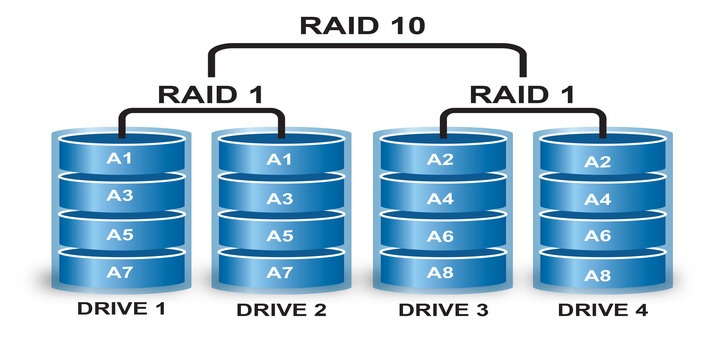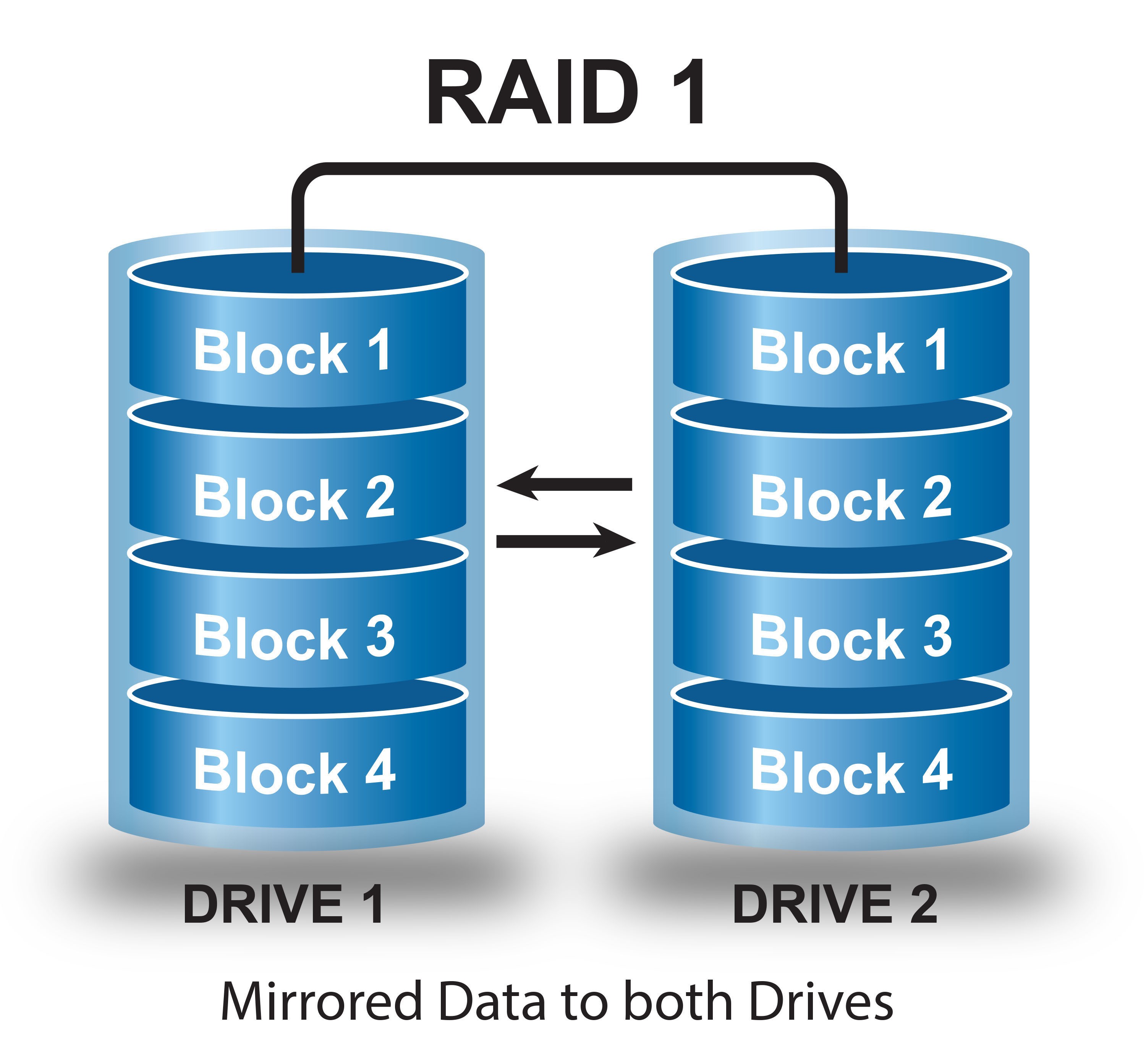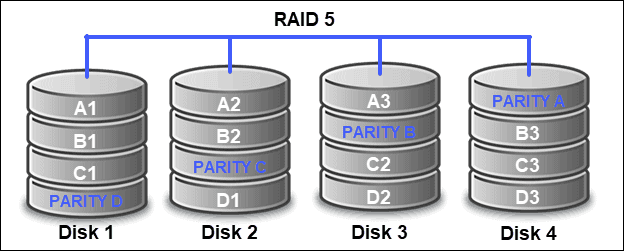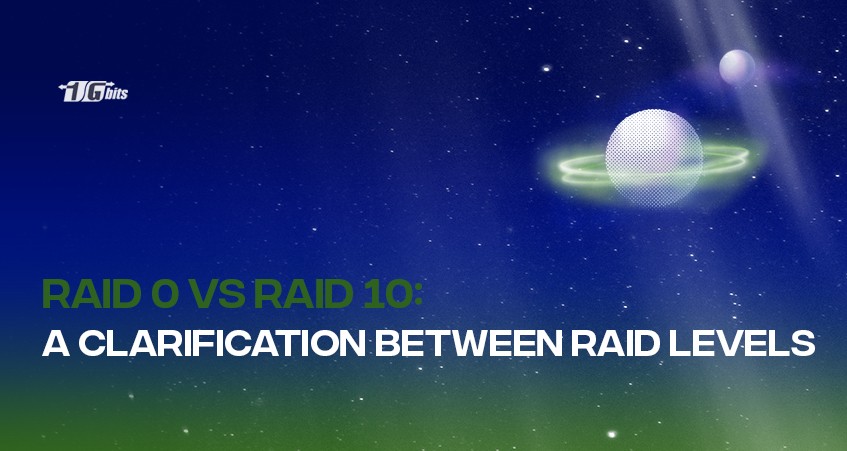To make a comparison between RAID 0 and RAID 10, you must understand each RAID individually so you can decide which one is best for you. RAID stands for redundant Array of Inexpensive (Independent) Disks. The RAID levels implemented on a system dramatically affect the exact speed and fault tolerance levels.
The RAID levels matter if it's either hardware or software because the hardware-based RAID supports more levels than the software ones. There are several popular RAID levels, including RAID 0, RAID 1, RAID 5, RAID 6 and RAID 10. Let us take a deeper look at each of these RAID levels.
What is RAID 0?

RAID 0 can be described as a connection between two or more physical discs. This connection makes the discs appear as a single logical drive. There is a catch in this connection. The total amount of memory will be equal to the smallest drive size multiplied by the number of total drives.
For example, if you have connected two drives with RAID 0 connection, one with 250GB capacity and 250GB, you will have the final capacity according to this formula 250x2=500GB.
Advantages of RAID 0
- The capacity of the whole array is considered a single entity which increases the read and writes speed.
- Data is distributed over the entire array to make maximum use of the memory space.
- A fast method to store and retrieve data.
- Reliable connection technique.
- No redundancy.
- With a minimum of 2 disks, RAID 0 can be implemented.
Disadvantages of RAID 0
- This singularity means if one disc fails, all the data on the other discs is also compromised. You can have a loss of data or contamination on the complete array.
- Since all the data is scattered on the entire array, the data recovery process becomes time-consuming and hectic.
- It is almost impossible to collect stripped data.
- When you use third-party tools to recover lost data, there are still chances of data loss.
- The array's total capacity depends on the ability of the smallest drive.
When RAID 0 is useful
- Build a cheap and efficient array
- Take benefit from its write/read speed.
- You have an almost equal size of drives.
What is RAID 10?

As mentioned earlier, a Redundant Array of Independent (or Inexpensive) Disk is the acronym of RAID. There are several other levels from 0 to 9 for the same purpose with different benefits. RAID 10 is the combination of RAID 1 and RAID 0.
Mirroring is the term that defines writing data on two or more hard drive disks (HDDs) at the same time. You can benefit from the mirroring as when one disk fails; your mirror image preserves the data from the failed disk.
RAID 10 consists of a minimum of four drives and combines the advantages of RAID 0 and RAID 1 in one single system. It provides security by mirroring all data on secondary drives while using striping across each set of drives. This results in speeding up data transfers.
This means that RAID 10 can provide the speed of RAID 0 combined with the redundancy provided by the RAID 1 configuration. You can lose any single drive and possibly even a 2nd drive without losing any data.
Advantages of RAID 10
- Fast and resilient combination of two storage levels.
- Relatively an inexpensive fix.
- "Chunks" are written in succession to different disks.
- Chunks of data can be read and written simultaneously from different drives.
- It isn't difficult and only takes a few minutes.
Disadvantages of RAID 10
- The mirror takes over before you take a copy of the failed disk.
- It Cuts usable disk space in half.
- You need a disk controller that supports RAID.
- You need at least four physical hard drives to implement RAID 10.
RAID 10 Is Not Backup.
Even though RAID 10 writes data on two hard drives simultaneously, it is still not your traditional backup. If the data on one drive is corrupted, it will corrupt them on both drives. When you are using RAID, you must use an effective backup system. And beware of the fact if you feel any issue in your data, don't overwrite the previous backup; instead, use some other location.
Notable RAID levels
What is RAID 1?

RAID 1 is a setup comprising a minimum of two drives that contain the same data. With this structure, the others will still work if one drive fails. This is a recommended feature for users who needs high reliability. The data can be read off any of the drives in the array, providing very high read performance.
While the read speeds are high, the write speeds are slow as the data needs to be written to all the drives in the array.
What is RAID 5?

Implementing RAID 5 requires at least three drives, striping the data across multiple drives similar to RAID 0, but it includes a "parity" distributed across the drives. A parity drive is a hard drive used in a RAID array to provide fault tolerance.
RAID 5 has zero downtime with extremely high read speeds, but the write speed is somewhat slower due to the parity that has to be calculated. With this RAID configuration, in the event of a single drive failure, data is pieced together using the parity information stored on the other drives.
It is ideal for file and application servers that have a limited number of data drives. This is the best cost-effective option for providing both performance and redundancy. It is a perfect solution for Databases as it is heavily read-oriented.
A negative impact is that RAID 5 loses 33 percent of storage space (using three drives) for the parity drive. The most popular RAID 5 configurations use four drives, which lowers the lost storage space to 25 percent. It can work with up to 16 drives.
Conclusion
This tutorial covered the comparison between RAID 0 vs RAID 10 and some other RAID levels. For most small to medium-sized enterprises, RAID 5 and RAID 10 suffice for good fault tolerance and performance. If you have a limited budget and want to get the most out of the disks you have popped into your array, RAID 5 will be ideal.
For extensive data operations such as server farms and data centres, where budgets will be bigger and performance more critical, RAID 10 offers the most benefits. You can check out our VPS solutions which have RAID 10 configurations integrated.
People also read:








